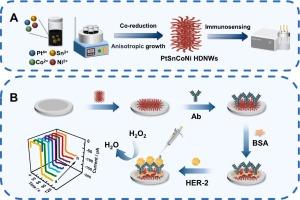高活性PtSnCoNi分层树突状纳米线的简单合成极大地增强了生物标志物HER-2的超灵敏免疫分析信号放大
IF 4.5
2区 化学
Q1 BIOCHEMISTRY & MOLECULAR BIOLOGY
引用次数: 0
摘要
人表皮生长因子受体-2 (HER-2)是乳腺癌的关键生物标志物,对早期诊断和预后评估至关重要。在这项工作中,开发了一种基于PtSnCoNi分层枝晶合金纳米线(PtSnCoNi HDNWs)的无标记电化学免疫传感器,用于生物标志物HER-2的检测。这些纳米线是通过在聚胺中共还原触发的各向异性生长策略合成的。通过多种技术严格表征了它们的枝晶结构、多种组成以及对H2O2还原的优异催化性能。该传感器具有0.1 ~ 1,000,000 pg mL−1的宽线性范围(R2 = 0.9985)和0.068 pg mL−1的低检出限(S/N = 3)。该方法在人血清样品中表现良好,回收率在103.8% ~ 105.3%之间,相对标准偏差在3.7%以下,验证了其临床适用性。这项工作突出了先进合金材料在开发用于早期癌症生物标志物检测的高性能生物传感器方面的潜力。本文章由计算机程序翻译,如有差异,请以英文原文为准。

Facile synthesis of highly active PtSnCoNi hierarchical dendritic nanowires greatly boosting signal amplification for ultrasensitive immunoassay of biomarker HER-2
Human epidermal growth factor receptor-2 (HER-2), a key biomarker in breast cancer, is critical for early diagnosis and prognosis evaluation. In this work, a label-free electrochemical immunosensor was developed for biomarker HER-2 detection based on PtSnCoNi hierarchical dendritic alloyed nanowires (PtSnCoNi HDNWs). These nanowires were synthesized via a co-reduction-triggered anisotropic growth strategy in oleylamine. Their dendritic structure, multiple compositions, and superior catalytic property for H2O2 reduction were rigorously characterized by multiple technologies. This biosensor demonstrated a broad linear range from 0.1 to 1,000,000 pg mL−1 (R2 = 0.9985) and a low detection limit of 0.068 pg mL−1 (S/N = 3). It performed well in human serum samples, achieving recovery rates ranging from 103.8 % to 105.3 % and a relative standard deviation below 3.7 %, validating its clinical applicability. This work highlights the potential of advanced alloy materials in developing high-performance biosensors for early cancer biomarker detection.
求助全文
通过发布文献求助,成功后即可免费获取论文全文。
去求助
来源期刊

Bioelectrochemistry
生物-电化学
CiteScore
9.10
自引率
6.00%
发文量
238
审稿时长
38 days
期刊介绍:
An International Journal Devoted to Electrochemical Aspects of Biology and Biological Aspects of Electrochemistry
Bioelectrochemistry is an international journal devoted to electrochemical principles in biology and biological aspects of electrochemistry. It publishes experimental and theoretical papers dealing with the electrochemical aspects of:
• Electrified interfaces (electric double layers, adsorption, electron transfer, protein electrochemistry, basic principles of biosensors, biosensor interfaces and bio-nanosensor design and construction.
• Electric and magnetic field effects (field-dependent processes, field interactions with molecules, intramolecular field effects, sensory systems for electric and magnetic fields, molecular and cellular mechanisms)
• Bioenergetics and signal transduction (energy conversion, photosynthetic and visual membranes)
• Biomembranes and model membranes (thermodynamics and mechanics, membrane transport, electroporation, fusion and insertion)
• Electrochemical applications in medicine and biotechnology (drug delivery and gene transfer to cells and tissues, iontophoresis, skin electroporation, injury and repair).
• Organization and use of arrays in-vitro and in-vivo, including as part of feedback control.
• Electrochemical interrogation of biofilms as generated by microorganisms and tissue reaction associated with medical implants.
 求助内容:
求助内容: 应助结果提醒方式:
应助结果提醒方式:


